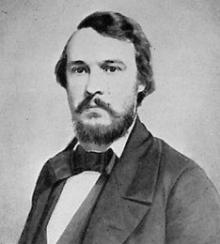- Home
- Archival Material
- College History Projects
- Subject-Based Digital Projects
Caleb Burwell Rowan Kennerly (1829-1861)

Caleb Burwell Rowan Kennerly was born to Reverend Thomas Kennerly and Ann Susan Carnegy in 1829. Kennerly grew up on his family’s Greenway Court estate in White Post, Virginia. He entered Dickinson College in Carlisle, Pennsylvania with the class of 1849. While an undergraduate, he was elected to the Belles Lettres Literary Society and, more significantly, gained an interest in ornithology after taking the innovative field trip biology classes with Professor Spencer Fullerton Baird. Kennerly graduated in 1849 with a Bachelor of Arts degree and went on to study medicine, gaining his doctorate in 1852 from the University of Pennsylvania.
Maintaining his contacts with his mentor, who moved to the post of assistant secretary of the Smithsonian Institution in 1850, Kennerly was able to develop his skills as a naturalist when Baird recommended him to a succession of important government sponsored expeditions. From 1853 to 1854 Kennerly was employed as a surgeon-naturalist on the Pacific Railroad Survey along the 35th parallel from Fort Smith, Arkansas to the Mojave Desert under Lieutenant Amiel Weeks Whipple and Second Lieutenant Joseph Christmas Ives. He then participated in the United States Mexican Boundary Survey from 1855 to 1857, and from 1857 to 1861 Kennerly was surgeon-naturalista of the U.S./U.K. joint Northwestern Boundary Survey that mapped the 409 mile north-west frontier between Canada and the Washington Territory. Many of Kennerly's writings are kept in the archives of the Smithsonian Institution today, including a diary from June 19, 1853 to April 10, 1854, covering his travels from San Antonio, Texas to California on the Pacific Roadroad survey and his twelve year correspondence with Spencer Baird, who later credited Kennerly for the discovery of over one hundred specimens.
The Smithsonian lost one of its most valuable naturalists when on completion of the Northwest Survey Kennerly decided to return to Virginia to be married. On February 6, 1861, four days out from San Francisco, off the coast of Acapulco, he died of a sudden brain disorder and was buried at sea. The Kennerly family built a cenotaph in his honor in White Post, Virginia. He was thirty-two years old.
Image courtesy of the Smithsonian Institution, Smithsonian Archives, Washington D.C., August 2000.
Date of Post:
2005
College Relationship:
Alumnus/Alumna Class Year: